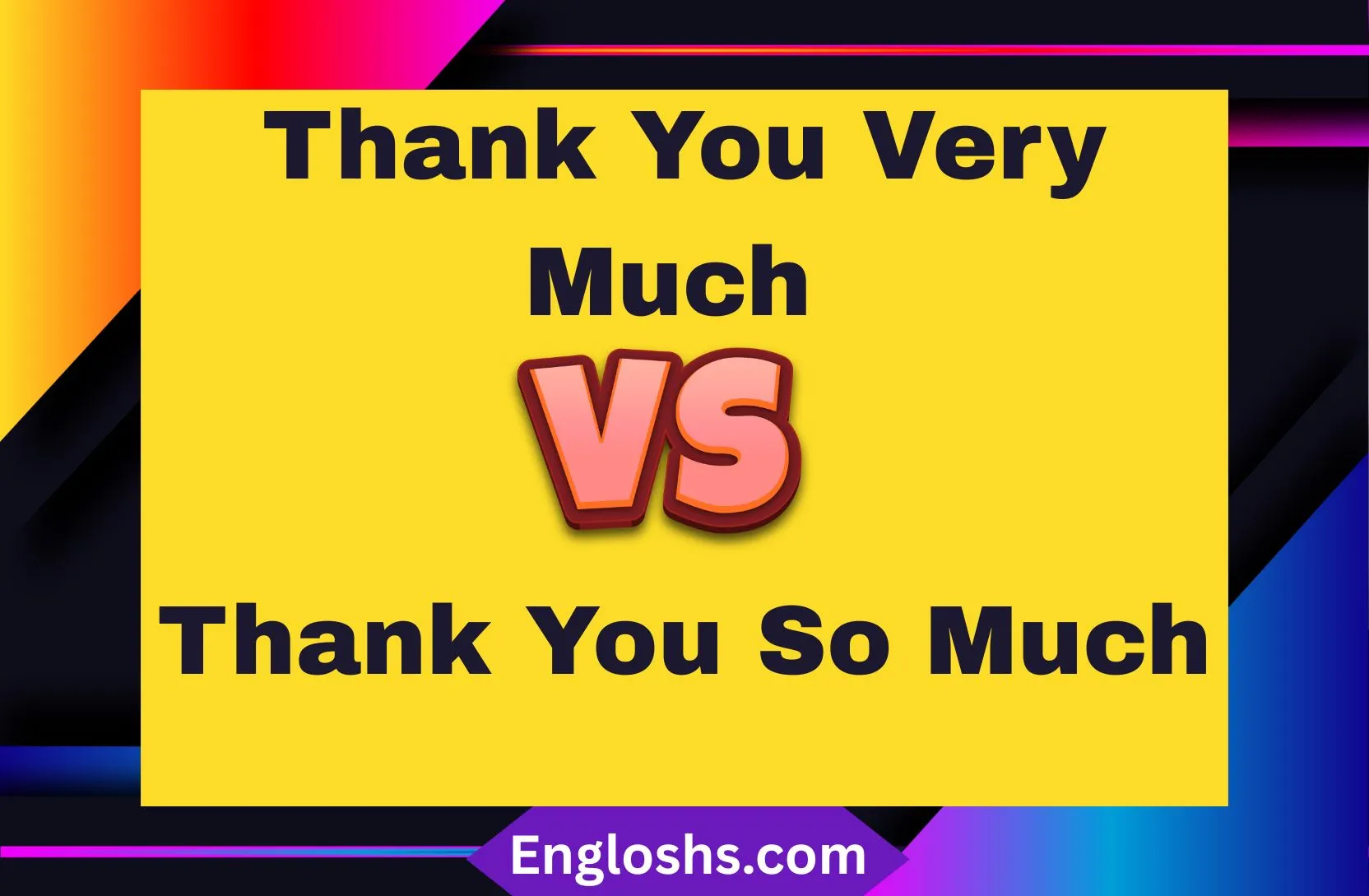Both phrases express gratitude, but there’s more to them than meets the eye. “Thank you very much” and “thank you so much” might seem interchangeable, yet they carry different connotations depending on tone, context, and even generation.
So which one should you use—and when? Let’s break it down.
“Thank you very much” is more formal and composed, while “thank you so much” sounds warmer, more emotional, and casual.
The Fine Art of Saying Thank You in English
English offers plenty of ways to say “thank you,” but small word choices can dramatically shift the tone.
At a glance:
- “Thank you very much” often feels more polished, reserved, or even formal.
- “Thank you so much” has a warmer, more emotional ring.
While both phrases are polite and grammatically correct, the difference lies in how they’re perceived, not just how they’re structured.
Here’s what makes English gratitude nuanced:
- The words we choose reflect emotion.
- Tone of voice and body language can reinforce—or contradict—the message.
- Context (social, cultural, generational) plays a huge role in how your gratitude is received.
The Subtle Differences Between “Very” and “So” in Thanks
Let’s dissect the key modifiers: very and so.
| Word | Function | Implication | Emotional Strength |
|---|---|---|---|
| Very | Intensifier | Formal, controlled emphasis | Moderate |
| So | Degree modifier | Emotional, expressive | Higher |
“Very much” feels traditional and restrained—like holding a thank-you note in your hand.
“So much” feels like a warm hug—it overflows with appreciation.
Example comparison:
- “Thank you very much for your help.” → Polite, respectful, composed.
- “Thank you so much for your help!” → Sincere, heartfelt, friendly.
When to Use “Thank You Very Much” in Formal Situations
Certain environments call for etiquette, and “thank you very much” fits the bill.
Best contexts for “thank you very much”:
- Professional emails
“Thank you very much for considering my application.” - Job interviews
“Thank you very much for your time today.” - Business meetings
“Thank you very much for the detailed update.” - Customer service
“Thank you very much for choosing our company.”
The phrase signals respect without sounding overly emotional—perfect when boundaries or protocol matter.
Examples of Formal Settings for Gratitude
Still not sure when to choose “very much”? Here’s a quick table of formal settings and ideal usage:
| Situation | Phrase Example |
|---|---|
| Business correspondence | “Thank you very much for your prompt response.” |
| Academic communication | “Thank you very much for your feedback.” |
| Customer/client relationships | “Thank you very much for your continued support.” |
| Government or legal settings | “Thank you very much for your cooperation.” |
Pro Tip: Pair “thank you very much” with neutral or professional tones. Avoid emojis or slang.
Understanding the Tone of Formality in Expressions of Thanks
Tone makes or breaks your message. “Thank you very much” conveys:
- Professional courtesy
- Respectful distance
- Politeness without warmth
But used with the wrong tone (like sarcasm or disinterest), it can backfire.
Sarcastic example:
“Oh, thank you very much for the last-minute notice.”
That extra formality can sound passive-aggressive if not delivered sincerely. Always match your tone to your words.
The Increasing Popularity of “Thank You So Much” in Casual Contexts
Enter the softer, more personal sibling: “thank you so much.”
This version has grown in popularity, especially:
- Among younger generations
- On social media
- In casual work cultures
- During emotional or personal moments
Why?
Because it feels more human. There’s vulnerability and warmth baked into “so much.”
Where it works best:
- Text messages
“Thank you so much for checking in ❤️” - Friendly emails
“Thank you so much! You’re a lifesaver.” - Social media shout-outs
“Thank you so much for the love and support!”
Cultural and Generational Variations in Saying Thanks
Gratitude isn’t just linguistic—it’s cultural.
Generational Trends:
- Boomers and Gen X tend to prefer “thank you very much.”
- Millennials and Gen Z often lean into “thank you so much,” especially in informal or digital spaces.
Cross-cultural perceptions:
| Culture | Common Expression | Perceived Politeness Level |
|---|---|---|
| US (Business) | “Thank you very much” | High |
| UK (Everyday) | “Cheers” or “Thanks a lot” | Moderate |
| Japan | “Dōmo arigatō gozaimasu” (very polite) | Very High |
| France | “Merci beaucoup” | High |
Tone, body language, and context are just as important as the words themselves. What’s polite in one culture might seem stiff or over-the-top in another.
How Different Cultures Perceive Sincerity in Thanks
In some cultures, overdoing gratitude can feel unnatural or even disingenuous.
Examples:
- German culture tends to value precision and may find overly expressive thanks unnecessary.
- American culture embraces open emotional displays, so “thank you so much” feels right at home.
- In Japan, tone and hierarchy are everything—word choice depends heavily on status and occasion.
Tip: Mirror the level of formality you’re receiving—especially in global business or multicultural teams.
Maximizing the Impact of Your Gratitude with the Right Phrase
Whether you choose “very much” or “so much,” the goal is the same: authentic appreciation.
Here’s how to make your thanks count:
- Match your tone to the situation. Don’t overdo it or underplay your gratitude.
- Be specific. Add context to show you genuinely value what the person did.
“Thank you so much for staying late to help with the presentation.” - Add a personal touch. Even a short follow-up or note can boost the impact.
- Avoid robotic repetition. Vary your expressions:
- “I truly appreciate it.”
- “Much appreciated.”
- “Thanks a ton!” (casual)
Quick Reference Table
| Phrase | Best For | Emotional Strength |
|---|---|---|
| Thank you very much | Formal, professional | Moderate |
| Thank you so much | Casual, personal, emotional | High |
| Many thanks | Neutral, semi-formal | Moderate |
| Thanks a lot | Casual, sometimes sarcastic | Context-dependent |
❓ 6 FAQs
What’s the difference between “thank you very much” and “thank you so much”?
“Thank you very much” is formal and polite; “thank you so much” is more emotional and casual.
Is “thank you so much” more sincere than “thank you very much”?
It can feel more heartfelt in casual settings, but both are sincere when used appropriately.
Can I use “thank you so much” in a professional email?
Yes, especially in friendly work environments—but for formal tone, “thank you very much” is safer.
Is “thank you very much” outdated?
Not at all—it’s still widely used in formal or respectful contexts like job interviews and official emails.
Which generations prefer “thank you so much”?
Millennials and Gen Z often favor “thank you so much” in digital and casual communication.
Do different cultures prefer one over the other?
Yes—formality levels vary. Some cultures prefer reserved thanks (“very much”), while others welcome emotional gratitude (“so much”).
Final Thoughts
So what’s the real difference between thank you very much and thank you so much? One leans formal and reserved, the other warm and expressive.
There’s no wrong choice—just the right one for your context.
Use them wisely, and your gratitude will always hit the mark.





